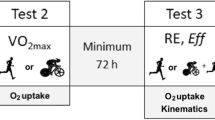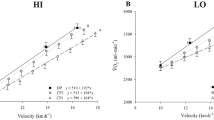Abstract
The aim of the present study was to compare the maximal isometric torque and cardio-respiratory parameters in well-trained young and master triathletes prior to and following an Olympic distance triathlon. One day before and 24 h following the event, participants performed three maximum voluntary isometric knee extensions and flexions and an incremental running test on a treadmill to determine the maximal isometric torque, maximal oxygen uptake \( \left( {\dot{V}{\text{O}}_{2\max } } \right) \), speed at \( \dot{V}{\text{O}}_{2\max } \) (vVO2max), speed at ventilatory thresholds (VT1 and VT2) and submaximal running economy. Prior to the event \( \dot{V}{\text{O}}_{2\max } \), vVO2max, speed at ventilatory thresholds and running economy were significantly lower in master athletes, but maximal voluntary torque was similar between the groups. 24 h following the race, a similar significant decrease in \( \dot{V}{\text{O}}_{2\max } \) (−3.1% in masters, and −6.2% in young, p < 0.05), and vVO2max (−9.5% in masters, and −5.6% in young, p < 0.05) was observed in both the groups. The speed at VT2 significantly decreased only in master athletes (−8.3%, p < 0.05), while no change was recorded in maximal voluntary torque or submaximal running economy following the event. The results indicate that for well-trained subjects, the overall relative exercise intensity during an Olympic distance triathlon and the fatigue 24 h following the event seem to be independent of age.



Similar content being viewed by others
References
Allen WK, Seals DR, Hurley BF, Ehsani AA, Hagberg JM (1985) Lactate threshold and distance-running performance in young and older endurance athletes. J Appl Physiol 58:1281–1284
Bentley DJ, Wilson GJ, Davie AJ, Zhou S (1998) Correlations between peak power output, muscular strength and cycle time trial performance in triathletes. J Sports Med Phys Fitness 38:201–207
Bernard T, Sultana F, Lepers R, Hausswirth C, Brisswalter J (2010) Age-related decline in olympic triathlon performance: effect of locomotion mode. Exp Aging Res 36:64–78
Bieuzen F, Hausswirth C, Louis J, Brisswalter J (2010) Age-related changes in neuromuscular function and performance following a high-intensity intermittent task in endurance-trained men. Gerontology 56:66–72
Borg GA (1982) Psychophysical bases of perceived exertion. Med Sci Sports Exerc 14:377–381
Cartee GD, Kietzke EW, Briggs-Tung C (1994) Adaptation of muscle glucose transport with caloric restriction in adult, middle-aged, and old rats. Am J Physiol 266:R1443–R1447
Coggan AR, Spina RJ, Rogers MA, King DS, Brown M, Nemeth PM, Holloszy JO (1990) Histochemical and enzymatic characteristics of skeletal muscle in master athletes. J Appl Physiol 68:1896–1901
Easthope CS, Hausswirth C, Louis J, Lepers R, Vercruyssen F, Brisswalter J (2010) Effects of a trail running competition on muscular performance and efficiency in well-trained young and master athletes. Eur J Appl Physiol 110:1107–1116
Fell J, Reaburn P, Harrison GJ (2008) Altered perception and report of fatigue and recovery in veteran athletes. J Sports Med Phys Fitness 48:272–277
Hausswirth C, Brisswalter J (2008) Strategies for improving performance in long duration events: Olympic distance triathlon. Sports Med 38:881–891
Howley ET, Bassett DR Jr, Welch HG (1995) Criteria for maximal oxygen uptake: review and commentary. Med Sci Sports Exerc 27:1292–1301
Kent-Braun JA, Ng AV, Young K (2000) Skeletal muscle contractile and noncontractile components in young and older women and men. J Appl Physiol 88:662–668
Le Gallais D, Hayot M, Hue O, Wouassi D, Boussana A, Ramonatxo M, Prefaut C (1999) Metabolic and cardioventilatory responses during a graded exercise test before and 24 h after a triathlon. Eur J Appl Physiol Occup Physiol 79:176–181
Lepers R, Sultana F, Bernard T, Hausswirth C, Brisswalter J (2010) Age-related changes in triathlon performances. Int J Sports Med 31:251–256
Lexell J (1995) Human aging, muscle mass, and fiber type composition. J Gerontol A Biol Sci Med Sci 50:11–16
Louis J, Hausswirth C, Bieuzen F, Brisswalter J (2009) Muscle strength and metabolism in master athletes. Int J Sports Med 30:754–759
Millet GY, Lepers R, Maffiuletti NA, Babault N, Martin V, Lattier G (2002) Alterations of neuromuscular function after an ultramarathon. J Appl Physiol 92:486–492
Millet GY, Martin V, Lattier G, Ballay Y (2003) Mechanisms contributing to knee extensor strength loss after prolonged running exercise. J Appl Physiol 94:193–198
Nicol C, Avela J, Komi PV (2006) The stretch-shortening cycle : a model to study naturally occurring neuromuscular fatigue. Sports Med 36:977–999
Peiffer JJ, Abbiss CR, Chapman D, Laursen PB, Parker DL (2008) Physiological characteristics of masters-level cyclists. J Strength Cond Res 22:1434–1440
Pimentel AE, Gentile CL, Tanaka H, Seals DR, Gates PE (2003) Greater rate of decline in maximal aerobic capacity with age in endurance-trained than in sedentary men. J Appl Physiol 94:2406–2413
Porter MM, Vandervoort AA, Lexell J (1995) Aging of human muscle: structure, function and adaptability. Scand J Med Sci Sports 5:129–142
Reaburn P, Dascombe B (2008) Endurance performance in masters athletes. Eur Rev Aging Phys Act 5:31–42
Sial S, Coggan AR, Hickner RC, Klein S (1998) Training-induced alterations in fat and carbohydrate metabolism during exercise in elderly subjects. Am J Physiol 274:E785–E790
Tanaka H, Seals DR (2008) Endurance exercise performance in Masters athletes: age-associated changes and underlying physiological mechanisms. J Physiol 586:55–63
Trappe SW, Costill DL, Vukovich MD, Jones J, Melham T (1996) Aging among elite distance runners: a 22 year longitudinal study. J Appl Physiol 80:285–290
Wiswell RA, Jaque SV, Marcell TJ, Hawkins SA, Tarpenning KM, Constantino N, Hyslop DM (2000) Maximal aerobic power, lactate threshold, and running performance in master athletes. Med Sci Sports Exerc 32:1165–1170
Author information
Authors and Affiliations
Corresponding author
Additional information
Communicated by David C. Poole.
Rights and permissions
About this article
Cite this article
Sultana, F., Abbiss, C.R., Louis, J. et al. Age-related changes in cardio-respiratory responses and muscular performance following an Olympic triathlon in well-trained triathletes. Eur J Appl Physiol 112, 1549–1556 (2012). https://doi.org/10.1007/s00421-011-2115-9
Received:
Accepted:
Published:
Issue Date:
DOI: https://doi.org/10.1007/s00421-011-2115-9




